The City of Mandurah is 72km south of the state capital, Perth. It became a shire on July 1st 1961, a town 26 years later and eventually a city on April 14th, 1990. The growth of the city, from a small fishing village to a prominent tourist hotspot, is a testament to the vision held by the people and the City of Mandurah Council.
Planning for the Future
Mandurah’s infrastructure has been a key component in the Council’s ability to deliver the best for its residents, as well as visitors. With a projected growth in population from 85,000 to 130,000 over the next 20 years, the Council has been planning well ahead to make sure energy, transport, sanitation and environmental needs are met.
Allan Claydon, Director of Works and Services, has been overseeing the City’s municipal projects.
“As the city’s population has grown, this has put demand on our infrastructure and services, and we’re fortunate to have a competent workforce who can meet the city’s needs now and into the future in terms of major community infrastructure projects,” he explains.
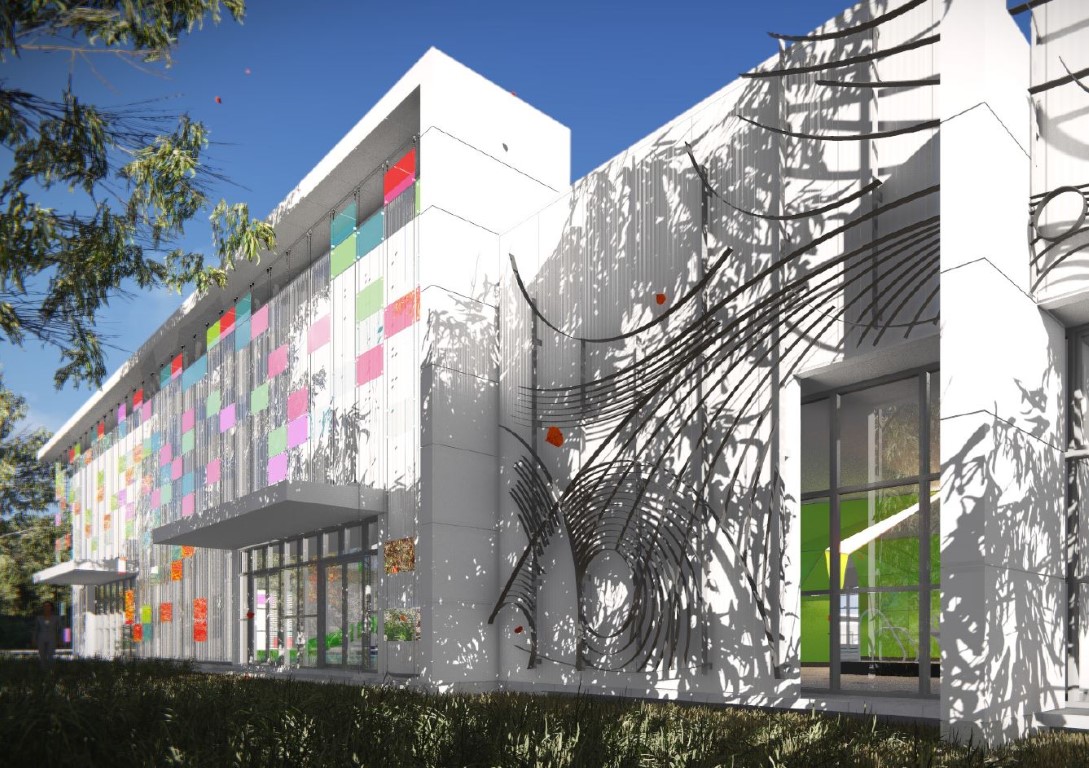
Mandurah Aquatic and Recreation Centre
The City wanted to create top-class facilities which could cater to both the local populous and have an appeal to international sporting events. As Mandurah’s Chief Executive Officer Mark Newman explains, the need for a major redevelopment of the City’s aquatic and recreation centre:
“The previous building was nearly 30 years old, when the town had a population of less than 20,000. Basically, you had one eight-lane 25m pool and one six-lane 25m pool, with the last modifications being done in 1994.”
Stage one focused on a $22 million upgrade of the aquatic facilities, which was completed in September, 2015. Everything is bigger, better and built to last longer.
“There is now a 50m outdoor pool which can be split. We can alter it for whatever configuration we like. The 25m indoor pool has been completely rejuvenated and there is also good variety, including an aquatic playground for kids, which is great, especially in the school holidays. We now have a top-class facility for a regional centre. It’s been a huge success since opening, and we’re working to attract and secure regional and state events for the coming years,” says Newman.
Stage two, a $20 million development, focuses on the dry areas of the recreation centre. Two new basketball and squash courts are being added, while the gym and administrative areas are reconstructed. With a projected completion date between July and August, 2016, this upgrade will see the existing floor size almost double.
The energy demands of running such a large complex have seen the City move away from more conventional sources, focusing instead on environmentally sustainable initiatives which will pay for themselves within a few years. Geothermal heating of the centre, which involves extracting heat sources from 1050m below ground, is a $4.5 million project the City has undertaken to keep the centre heated in an environmentally friendly way. While the drilling process is a bit complicated, Newman says the payback will be noticeable.
“It will save around $80,000 a month in heating costs. Obviously we still have the boilers in there which you need when the system goes down but we know what it costs per month so it will pay for itself in five years. It’s a fantastic project, supported by both the State and Federal governments –through the Community Energy Efficiency Program. That’s helped to make it even more viable.”
With a price tag close to $50 million, Newman has worked closely with the State and Federal Government to ensure all the costs were met in a timely manner.
Tourism
Mandurah has a history and dedication towards attracting tourists to the city. With a tourism team focusing on attracting and branding the city and region (the Mandurah and Peel Tourism Organisation) there has been a significant increase in the number of people coming to the city.
In 2018, the city will be hosting the Police and Services Games, in which more than 2000 participants will be taking part.
The Council is actively targeting these types of events to bolster tourism while still recognising the strong drawcard of historical events which take place.
One recognisable event is the local Channel Seven Mandurah Crab Fest, which takes place in the second week of March and attracts crowds upwards of 100,000. Summer events also attract sizeable numbers, with more than 20,000 people turning up for the Community Christmas Pageant and New Year’s Eve celebrations. The Stretch Arts Festival is also well-established community event.
Eastern Foreshore Redevelopment
Being such an iconic part of the city’s tourist appeal, the Council is starting a redevelopment of the Eastern Foreshore, which has currently outlived its viability in terms of space and appeal.
The $12.5 million project will see the existing seawall replaced along with further redevelopment of the foreshore subsequent to it, providing a more contemporary space for people of all ages and abilities.
Director of Works and Services – Allan Claydon says the project received a ringing endorsement from the community when the initial concept plans were revealed. The indigenous community was also consulted and has similarly endorsed the project.
“What we will provide in terms of tourism is a very creative event space. One of the features of this is a performance space located in the foreshore and what we’ve proposed is an Amphitheatre that broadcasts itself out across the water, so it’s quite a unique feature,” he says.
As a low lying area, there was a need to build the wall up to address climate change. The Council will use the increase in height to provide ramps and seating for people to experience the water-edge up close.
The new seawall is set to be completed later this year.
Delivering effective outcomes within budget can be a challenge for the Council, especially on red tape issues. Claydon says this can take all the energy, drive and budget out of the project, although he believes it is worth the effort.
“We’ve got a very strong argument to upgrade the foreshore and waterway for our community, visitors and future events. We’re a very easy–to–reach destination, so this is one way of enhancing that from an economic viewpoint. There are not many places out of Perth which can provided the amenities we provide,” Claydon says.
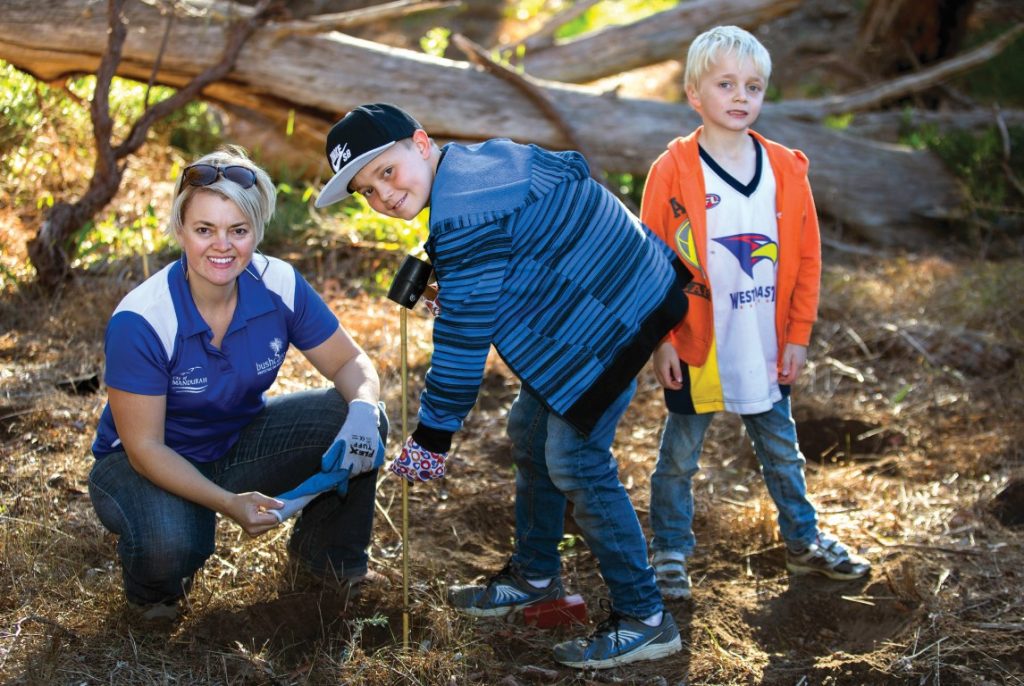
Sustainability Partnerships
Chief Executive Officer Mark Newman outlines economic, environmental and social aspects as the three planks of the City’s strategic plan.
The City has been collaborating with the Peel Harvey Catchment Council for the past 12 years, focusing on the drainage into the Peel-Harvey Estuary. As Newman explains, the estuary is a big part of the city, and protecting it from human wastage and offsets is crucial.
“Without the estuary I don’t know what we’d be. In 1994 we actually introduced a more robust marine life. The things which made the algae bloom was heavy metal from drains, farming and residential developments. The Peel Harvey Catchment Council was formed to liaise as a partner with councils on how they put drains in. It became the last Natural Resource Management area to be announced through the State Government last year and Council has continued to sponsor them through the process.”
The Council partners with universities on estuary-related projects, which have been so successful, the Federal government is now funding them directly.
Newman is also conscious of the economic challenges of building up an economically vibrant CBD.
“Mandurah used to be a fishing village and the CBD was built around it. I suppose we’re going to have to keep a focus on employment outcomes in the CBD. Professional offices can change the type of employment[they provide]. We’re focused on construction and retail and we need to diversify out. The other area we’re working on is finding niche programs in terms of entrepreneur programs and the Artpreneur programs that have really caught on. Growth is uncapped,” he says.
Solar Panels
An environmental focus has been a strong part of the Council’s long-term vision. It has worked to set a carbon emissions reduction target and has found leading by example is an effective way to make a change. They took a scientific approach to it, installing Photovoltaic (PV) Panels on a number of Council buildings, including the Mandurah Bowling and Recreation Centre, the Mandurah Performing Arts Centre and the City’s administration building. In doing so, they made sure the panels were well concealed.
Newman says the benefits of renewable energy are noticeable, being both cost efficient and having positive spillover effects.
“We could see it could pay for itself in a very short period of time, with a payback period in 3-4 years. Any savings are put straight into other energy savings projects. It’s been really worthwhile and so far the projects we’ve put them in, we’re exceeding expectations both with carbon emissions and energy costs.”
The leadership by example has paid off, with Mandurah residents being some of the highest users of solar panels in the state. Some of the smaller recreation clubs have also started to ask for assistance, leading to the growing momentum in the use of renewable energy.
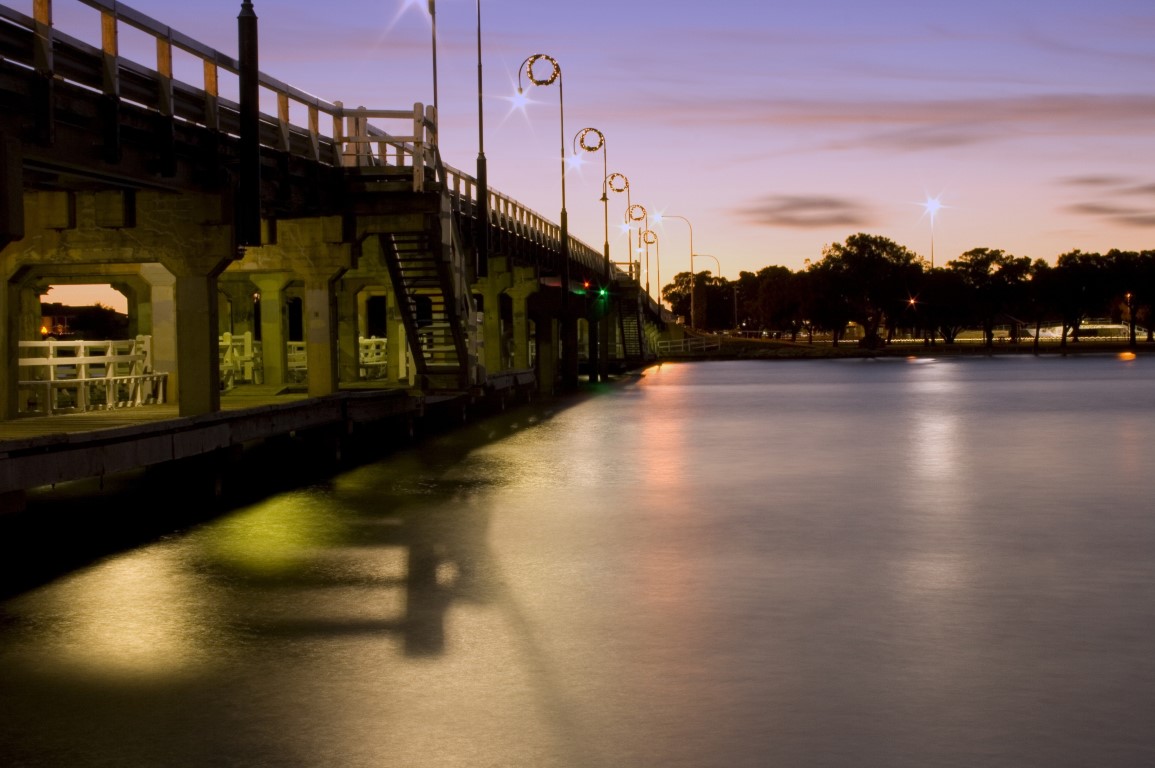
Old Mandurah Traffic Bridge
Transport upgrades have been a noticeable feature in the Mandurah’s development plan. One notable project was the upgrade of the 62-year–old Old Mandurah Traffic Bridge. The $51 million project was granted funding from Federal and State levels, with the Council also contributing. Once completed, it will be four lanes wide and have a far more modern feel to it.
Claydon says there was a lot of public consultation, helping residents to recognise it’s practical needs whilst still maintaining some of the bridge’s heritage.
“The shape and form has been there for so long. In recognition of that, there will be a portion of the structure maintained to recognise the heritage value. So a portion will be maintained and refurbished so citizens can do their fishing and crabbing,” he says.
The new bridge is based off broad designs to ensure there is less intrusion into the waterways. The new bridge will feature four pile seats in the water whereas previously it was 23, further minimising the overall impact on the environment.
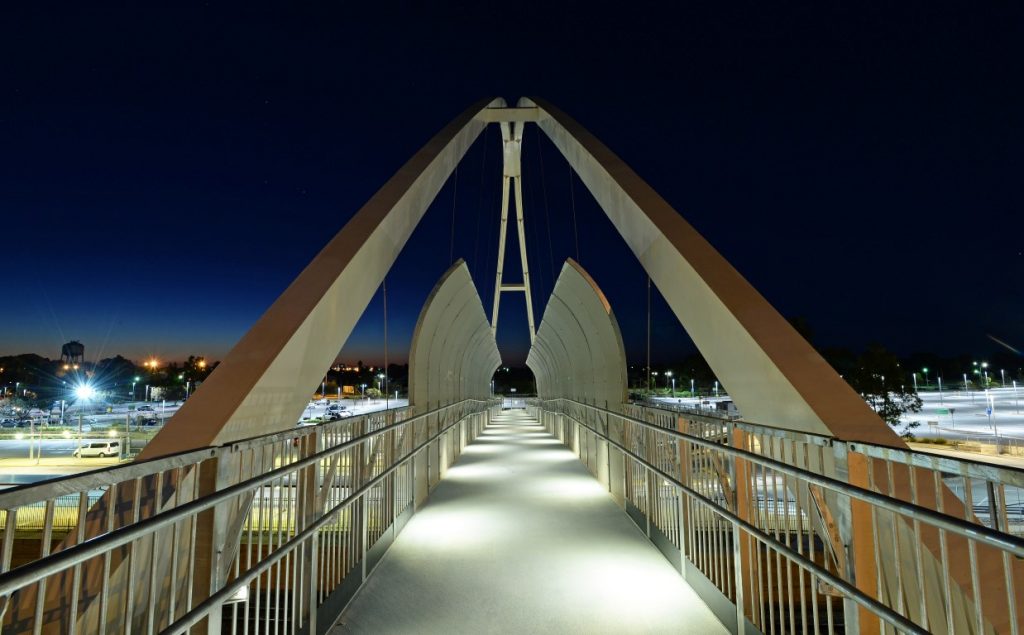
New Walkover Bridge – City of Mandurah
Mandurah Road Pedestrian Bridge
This bridge was built with the intention of providing an entrance into the city centre itself, as well as providing an essential linkage between the train station and future residential developments. There is a greater ease of access to the railway and bus station, while also providing better movement for cyclists and people with disability. Allan Claydon explains design and development in detail.
“The double arch cable state bridge was designed and built in a three-dimensional manner. It was developed with double arch for two reasons. The first is that it spans out as iconic structure, and secondly, by necessity, when the bridge is spanning state highway and electrified rail systems, there’s a need for a double arch,” he explains.
Their hope is that the bridge will provide residents with a more eco-friendly way to commute through the city. The City was recently announced the winner of the GK Waters Local Government Engineering Excellence Award for the Mandurah Road Pedestrian Bridge project.
Peel Regional Leaders Forum
Mandurah’s Council has formed many good working relationships inside and outside the city. One group is the Peel Regional Leaders Forum.
A collection of the region’s major stakeholders, the group has influence in development, environment and community. CEO’s of all the local governments in the region are members and the group meets on a regular basis to update each other and work together on projects they are engaged in.
Adam Denniss, Manager of Economic Development and Projects at the City says the collaboration benefits the Peel region immensely.
“The outcome of that is local governments are getting much more involved in economic development. City space activation and community focused work is looking at how they fit into the greater good. Supply chain, comparative advantage and this is a very different place for a lot of governments to be thinking. The City of Mandurah is a leader in this,” he says.
One of the big projects to come out of the blueprint was Transform Peel. The project targets a new industrial estate of almost 1,000 hectares. This is an environmental plan recognising that the area has a very sensitive environment. Water, environment and economic development makes up Transform Peel and the City of Mandurah will play a major part in all of this.
Denniss says the Forum also acts as an intermediary for councils to understand where their plans fit in with State and Federal government plans.
“The Forum allows local governments to see where exactly their plans fit in. As a lot of projects require State and Federal funding, it’s important. Otherwise people would go off and work in silos all alone.”
“The joint projects are coming through joint staff sharing, joint sharing of resources. Sharing capabilities lead to a stronger region,” he says.
Denniss is excited about the growth potential of Mandurah and the greater Peel area.
“There is a business case sitting up at the State Government level in the Treasury. And if it gets the tick, it’ll be a $70 million project. It’ll only work if the two groups work together.”
AT A GLANCE
WHO: City Of Mandurah
WHAT: Mandurah has a history and dedication towards attracting tourists to the city with a tourism team focusing on attracting and branding the city and region.
WHERE: WA 6210
WEBSITE: http://mandurah.wa.gov.au/
Supporting Partner
Peet ltd
http://www.peet.com.au/
Sponsored Advertorial
- Peet Limited


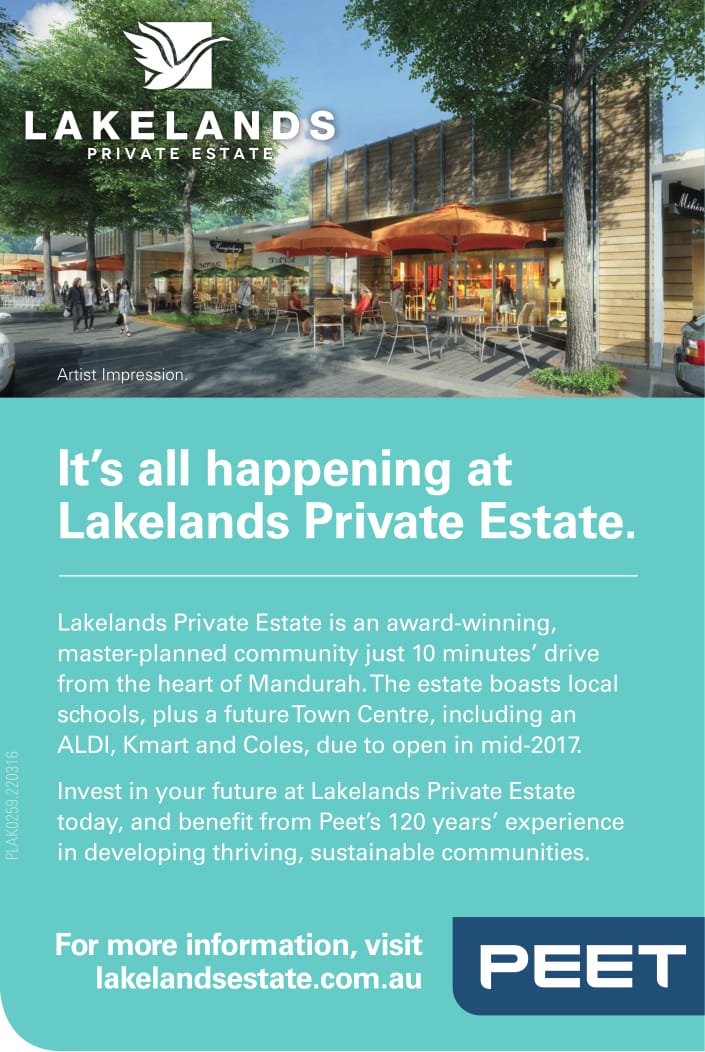
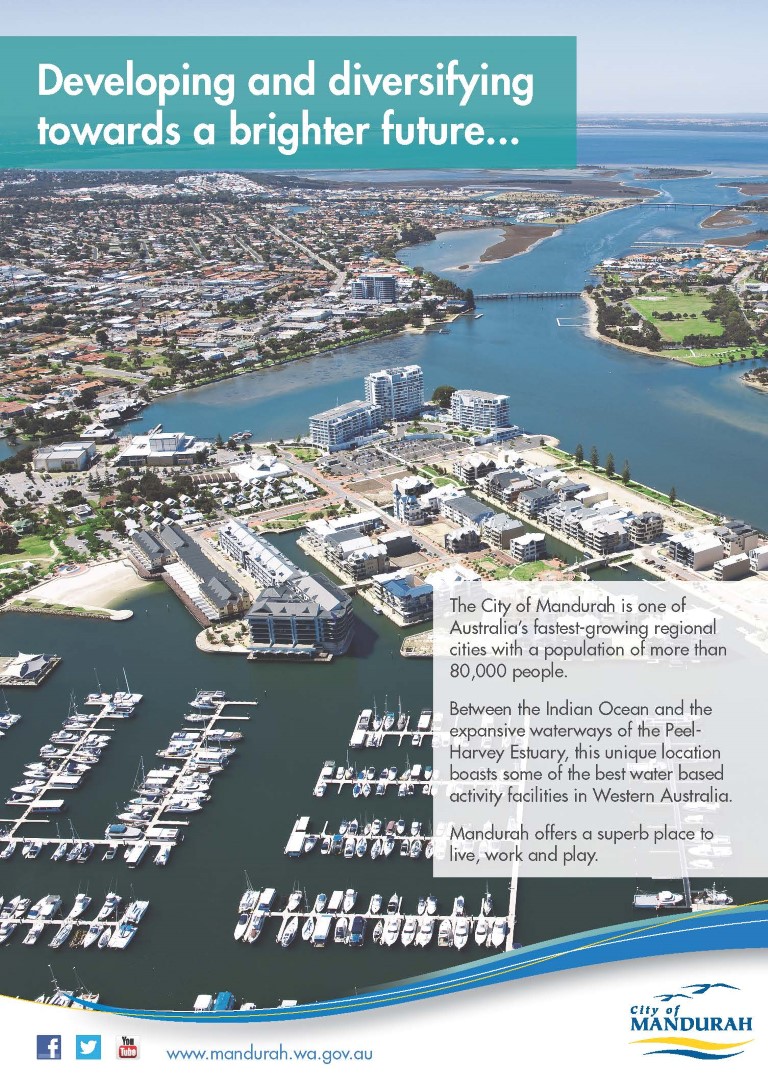
 This information will never be shared to third parties
This information will never be shared to third parties